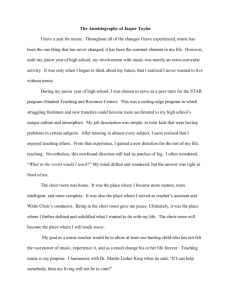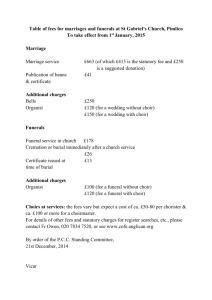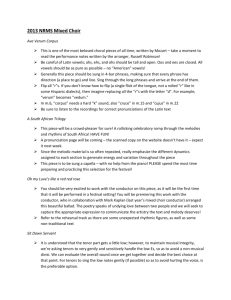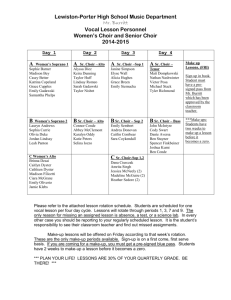Programme
advertisement
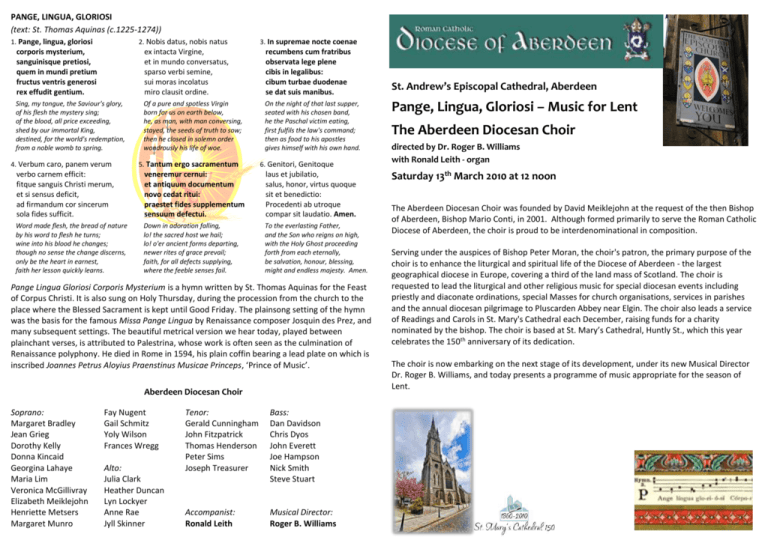
PANGE, LINGUA, GLORIOSI (text: St. Thomas Aquinas (c.1225-1274)) 1. Pange, lingua, gloriosi 2. Nobis datus, nobis natus 3. In supremae nocte coenae corporis mysterium, sanguinisque pretiosi, quem in mundi pretium fructus ventris generosi rex effudit gentium. ex intacta Virgine, et in mundo conversatus, sparso verbi semine, sui moras incolatus miro clausit ordine. recumbens cum fratribus observata lege plene cibis in legalibus: cibum turbae duodenae se dat suis manibus. Sing, my tongue, the Saviour's glory, of his flesh the mystery sing; of the blood, all price exceeding, shed by our immortal King, destined, for the world's redemption, from a noble womb to spring. Of a pure and spotless Virgin born for us on earth below, he, as man, with man conversing, stayed, the seeds of truth to sow; then he closed in solemn order wondrously his life of woe. On the night of that last supper, seated with his chosen band, he the Paschal victim eating, first fulfils the law's command; then as food to his apostles gives himself with his own hand. 4. Verbum caro, panem verum 5. Tantum ergo sacramentum 6. Genitori, Genitoque verbo carnem efficit: fitque sanguis Christi merum, et si sensus deficit, ad firmandum cor sincerum sola fides sufficit. veneremur cernui: et antiquum documentum novo cedat ritui: praestet fides supplementum sensuum defectui. laus et jubilatio, salus, honor, virtus quoque sit et benedictio: Procedenti ab utroque compar sit laudatio. Amen. Word made flesh, the bread of nature by his word to flesh he turns; wine into his blood he changes; though no sense the change discerns, only be the heart in earnest, faith her lesson quickly learns. Down in adoration falling, lo! the sacred host we hail; lo! o'er ancient forms departing, newer rites of grace prevail; faith, for all defects supplying, where the feeble senses fail. To the everlasting Father, and the Son who reigns on high, with the Holy Ghost proceeding forth from each eternally, be salvation, honour, blessing, might and endless majesty. Amen. Pange Lingua Gloriosi Corporis Mysterium is a hymn written by St. Thomas Aquinas for the Feast of Corpus Christi. It is also sung on Holy Thursday, during the procession from the church to the place where the Blessed Sacrament is kept until Good Friday. The plainsong setting of the hymn was the basis for the famous Missa Pange Lingua by Renaissance composer Josquin des Prez, and many subsequent settings. The beautiful metrical version we hear today, played between plainchant verses, is attributed to Palestrina, whose work is often seen as the culmination of Renaissance polyphony. He died in Rome in 1594, his plain coffin bearing a lead plate on which is inscribed Joannes Petrus Aloyius Praenstinus Musicae Princeps, ‘Prince of Music’. Aberdeen Diocesan Choir Soprano: Margaret Bradley Jean Grieg Dorothy Kelly Donna Kincaid Georgina Lahaye Maria Lim Veronica McGillivray Elizabeth Meiklejohn Henriette Metsers Margaret Munro Fay Nugent Gail Schmitz Yoly Wilson Frances Wregg Alto: Julia Clark Heather Duncan Lyn Lockyer Anne Rae Jyll Skinner Tenor: Gerald Cunningham John Fitzpatrick Thomas Henderson Peter Sims Joseph Treasurer Bass: Dan Davidson Chris Dyos John Everett Joe Hampson Nick Smith Steve Stuart Accompanist: Ronald Leith Musical Director: Roger B. Williams St. Andrew’s Episcopal Cathedral, Aberdeen Pange, Lingua, Gloriosi – Music for Lent The Aberdeen Diocesan Choir directed by Dr. Roger B. Williams with Ronald Leith - organ Saturday 13th March 2010 at 12 noon The Aberdeen Diocesan Choir was founded by David Meiklejohn at the request of the then Bishop of Aberdeen, Bishop Mario Conti, in 2001. Although formed primarily to serve the Roman Catholic Diocese of Aberdeen, the choir is proud to be interdenominational in composition. Serving under the auspices of Bishop Peter Moran, the choir's patron, the primary purpose of the choir is to enhance the liturgical and spiritual life of the Diocese of Aberdeen - the largest geographical diocese in Europe, covering a third of the land mass of Scotland. The choir is requested to lead the liturgical and other religious music for special diocesan events including priestly and diaconate ordinations, special Masses for church organisations, services in parishes and the annual diocesan pilgrimage to Pluscarden Abbey near Elgin. The choir also leads a service of Readings and Carols in St. Mary's Cathedral each December, raising funds for a charity nominated by the bishop. The choir is based at St. Mary’s Cathedral, Huntly St., which this year celebrates the 150th anniversary of its dedication. The choir is now embarking on the next stage of its development, under its new Musical Director Dr. Roger B. Williams, and today presents a programme of music appropriate for the season of Lent. Kyrie eleison. Kyrie eleison. Christe eleison. Christe eleison. Kyrie eleison. Kyrie eleison. Lord, have mercy. Christ, have mercy. Lord, have mercy. Gregorian chant is the central tradition of Western plainchant, a form of monophonic liturgical music within Western Christianity that accompanies the celebration of Mass and other ritual services. It is named after Pope Gregory I, Bishop of Rome from 590 to 604, who is traditionally credited for having ordered the simplification and cataloguing of music assigned to specific celebrations in the church calendar. The resulting body of music is the first to be notated in a system ancestral to modern musical notation. In its long history, Gregorian chant has been subjected to many gradual changes and some reforms. We begin today’s programme with the Kyrie from Mass XVII, dating from the 14th century. Tomás Luis de Victoria (1548-1611): O VOS OMNES (text: Lamentations 1:12) O vos omnes, qui transistis per vitam, attendite, et videte. Si est dolor similis sicut dolor meus. Attendite, universi populi, et videte dolorem meum. All ye who pass by, see if there be any sorrow like unto my sorrow. Tomás Luis de Victoria was the most significant composer of the Counter-Reformation in Spain, and one of the best-regarded composers of sacred music in the late Renaissance. He is sometimes known as the ‘Spanish Palestrina’ because he may have been taught by Palestrina. O vos omnes, today one of Victoria's best-known motets, first appeared as a Holy Week motet in his 1572 first published collection and later became part of the complete set of Tenebrae Responsories. The Tenebrae service itself was one of the most emotionally affective of the entire Catholic liturgy: over the course of its mournful readings from the Lamentations of Jeremiah and others, the 21 candles lighting the church were one by one snuffed out, leaving the worshippers in darkness, representing the world between Cross and Crucifixion. Victoria's setting of "O vos omnes" captures the very essence of Holy Week observances: ‘See if there be any sorrow like unto my sorrow.’ Hans Leo Hassler (1564-1612), harm. Johann Sebastian Bach (1685-1750): PASSION CHORALE (text: P. Gerhardt, based on Salve caput cuentatum (attr. St. Bernard of Clairvaux), tr. Sir. H. W. Baker) O sacred head, surrounded by crown of piercing thorn! O bleeding head, so wounded, so shamed and put to scorn! Death’s pallid hue comes o’er thee, the glow if life decays; Yet angel-hosts adore thee, and tremble as they gaze. Hans Leo Hassler, the German composer and organist of the late Renaissance and early Baroque, was one of the first to blend the innovations of the Italian virtuoso style with the traditional German style. He wrote the music of the now familiar Passion Chorale around 1600, for a secular love song, Mein Gmuth ist mir verwiret. The tune was appropriated for Gerhardt's German hymn in 1656. Johann Sebastian Bach arranged the melody and used it five times in his St. Matthew Passion. Bach also used this melody in the opening chorale and triumphant final chorus of his Christmas Oratorio. Today we frame the singing of the Passion Chorale with preludes based on it, beforehand by Bach himself, and afterwards by Johannes Brahms (1833-1897) (one of Brahms’ final works, written after the death of Clara Schumann). John Milford Rutter (b. 1945): THY PERFECT LOVE (text: 15th cent.) Jesu, my love, my joy, my rest, Thy perfect love close in my breast That I thee love and never rest; And make me love thee of all thinge best, And wounde my heart in thy love free, That I may reign in joy evermore with thee. John Rutter is an English composer, conductor, editor, arranger and record producer, mainly of choral music. Whilst director of music at Clare College, Cambridge from 1975 to 1979 he led their choir to international prominence. In 1981 Rutter founded his own choir, the Cambridge Singers, which he conducts and with which he has made many recordings of sacred choral repertoire. He still lives near Cambridge, but frequently conducts other choirs and orchestras around the world. Thy Perfect Love, set to a lilting, gently rocking tune, was written in 1974 at the request of a friend, John Preston Bell, for his parish church choir in the tiny village of Meopham in Kent. The words are by an unknown 15th century writer. Wolfgang Amadeus Mozart (1756-1791): AVE VERUM CORPUS (text: 14th cent., attr. Pope Innocent VI) Ave verum corpus natum de Maria Virgine; Vere passum, immolatum in cruce pro homine: Cuius latus per foratum unda fluxit et sanguine: Esto nobis praegustatum in mortis examine. Hail, true body born of the Virgin Mary, which truly suffered and was sacrificed on the cross for the human race, whose pierced side poured with water and blood: be to us a foretaste of the verdict to be passed at death. Ave verum corpus is a short Eucharistic hymn dating from the 14th century that has been set to music by various composers. Mozart’s is perhaps the best known of all, and is surely one of the most beautiful pieces of music ever composed. Composed in June 1791, in the last year of his life, it was dedicated to his friend, Anton Stoll, who was chorus master of the parish church in Baden. It is remarkable for its compact simplicity, of the sort that Artur Schnabel famously described as ‘too simple for children and too difficult for adults’ - the music seems to encompass a universe of feeling in forty-six short bars.
